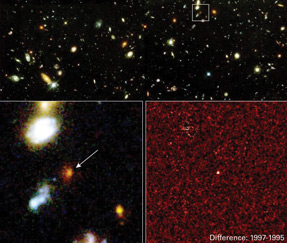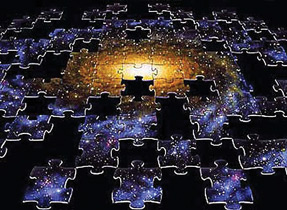|
Almost three quarters of our universe is comprised of dark energy, the
newest bewildering component of our cosmos.
Until just a decade ago, scientists were near unanimous in their
assumption on the fate of the universe. They thought that the cosmic expansion
triggered by the Big Bang would slow down over time or at least it would remain
unchanged. Gravity, being an attractive long-range force, pulls the components
of the universe together, thereby prohibiting unruly expansion. So they set out
to assess the expansion speed of the universe. Contrary to their expectations,
they found a universe that is accelerating.
 |
This computer-generated image shows the simulated distribution of dark matter in a galaxy cluster formed in the
universe with dark energy. The clumps are locations where galaxies form. |
“The data wasn’t behaving as we thought it would. There was a lot of
nervous laughter,” said Brian Schmidtat Australian National University, who led
one supernova search team.
The evidence of the unexpected expansion of the universe came from
observations of distant supernovae explosions. These are the brightest
explosions that can be seen over vast distances across the universe. Telescopes
measure the fine prints of such explosions.
 |
|
Light and shadow in the Carina Nebula |
When light begins its long journey from an exploding supernova, it has
to confront an expanding universe along its path. This expansion of space
“redshifts” the light waves. In other words, the wavelength of light is
stretched to the red end of the spectrum. The level of redshift and the
distance of the explosion allow us to measure the rate of the expansion of the
universe. These observational data form a large number of supernovae record the
expansion history of the universe.
Some unknown force is prompting the acceleration. This force is greater
than that neutralizing the combined gravitational pull of normal and dark
matter.
This discovery wasn’t cause for celebration among astronomers — rather
it was shocking. This strange phenomenon portrays a world vastly different than
the one we are used to. We expect a tossed object to fall back to earth unless
a force overcomes the gravity of our planet. On a grand scale, such an unknown
force is spurring the growth of the universe by flinging galaxies apart. To
accommodate that large repulsive force accelerating the universe, scientists
coined the term — dark energy.
The current cosmological theories predict the composition of our
universe as 75% dark energy, 21% dark matter and 4% normal matter. Incredibly,
we know very little about dark energy or dark matter. We live in a universe
ruled by the unknown.
Einstein’s theory of relativity hinted at a repulsive force in the
universe. He incorporated the idea of cosmological constant to support the idea
of static universe. He reasoned that for the universe to remain static, this
repulsive nature of the cosmological constant would surpass the effect of
gravity. When Edwin Hubble’s observation of galaxies proved the expansion of
the universe as opposed to a static universe, Einstein retracted his original
idea, calling it the “biggest blunder” of his career. Now, decades after his
death, some cosmologists think that Einstein’s blunder may come to the rescue.
They identify the cosmological constant as one of candidates for explaining
dark energy.
The most recent observations by the WMAP satellite provide evidence of
dark energy in the universe. In the absence of dark energy, the mass-energy
density of the universe is not sufficient to explain the flat geometrical shape
of the observable universe.
 |
|
A Giant Hubble Mosaic of the Crab Nebula. |
But what if these observations are fooling us? Are we missing some
fundamental truth about the universe? After all, we infer the existence of dark
energy only from the accelerating universe. We expect the universe to act
according to our known laws. Modifying Newtonian and Einsteinian laws would
have startling impact on how gravity works. It may eliminate the need for dark
energy. But astronomers are not prepared to admit the demise of dark energy
yet. A series of new tests using earth and space based telescopes are planned
to identify the ghostly energy.
Quantum mechanics views the cosmological constant as the “energy of the
vacuum,” or the energy of empty space. It is assumed that all space is filled
with this form of energy. This repulsive background energy associated with the
empty space could be dark energy. However, there is no compelling evidence for
that claim. The theoretical calculations suggest that the amount of vacuum
energy is too high for reasonable explanations.
Emptiness is not a true void as was deemed in the past. Quantum theory
considers a vacuum as a pool of virtual particles rapidly popping in and out of
existence. The particles and energy incarnate inside the so-called emptiness as
a result of invisible interactions.
 |
A
pinpoint of light from a star that exploded over 10 billion light-years
away is centered in the panel at the lower right, a cosmic
snapshot |
Other explanations point to the possibility of extra dimensions. The
dark energy might be lurking in those dimensions while we are stuck in our
three dimensional world. While it is imprisoned in those dimensions, its
gravitational effects can reach out into our space. Its gravitational force may
be repulsive in our universe.
These are all scientific speculations until supporting evidence is
lined up. Unfortunately, our observations and measurements depend upon
something we cannot comprehend yet. We know the laws of gravity account for the
behavior of our solar system pretty well. But, how do we know if our laws of
gravity don’t break down over huge distances? Or even worse, it might be
possible that we are unaware of some long-range forces other than gravity.
Determined to break the impasse, NASA and the U.S Department of Energy
have together decided to develop a space based dark energy investigation. This
strategic mission known as JDEM —Joint Dark Energy Mission — is currently in
the design phase. The JDEM observatory is set to launch in 2016 to study the
properties of dark energy and assess the expansion rate of the universe over
different time periods during its cosmic evolution.
Until we understand, we have to confront the dark forces of nature. If
this phantom energy exists, it will rip our universe apart leaving us alone in
the island of Milky Way surrounded by huge emptiness. If it doesn’t, for our
future generations dark energy may come to symbolize the extent of our
ignorance.
 |
How will our universe end? Recent speculation
now includes a pervasive growing field of
mysterious repulsive energy that rips virtually
everything apart. As soon as few billion years
from now, the controversial scenario holds, dark
energy will grow to such a magnitude that our
own Galaxy will no longer be able to hold itself
together. After that, stars, planets, and then
even atoms might not be able to withstand the
expansive internal force. |
|







